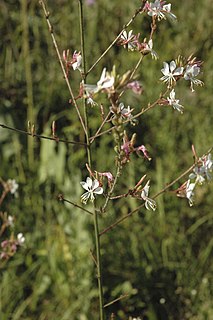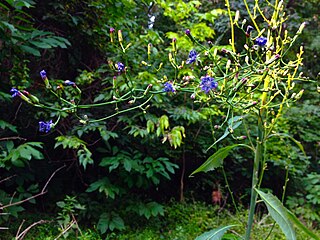
Oenothera biennis, the common evening-primrose, is a species of flowering plant in the family Onagraceae, native to eastern and central North America, from Newfoundland west to Alberta, southeast to Florida, and southwest to Texas, and widely naturalized elsewhere in temperate and subtropical regions. Evening primrose oil (EPO) is produced from the plant.

Grindelia squarrosa, also known as a curly-top gumweed or curlycup gumweed, is a small North American biennial or short-lived perennial plant.

Hymenopappus is a genus of flowering plants in the daisy family. Many species are known as woollywhites.

Lactuca biennis is a North American species of wild lettuce known by the common names tall blue lettuce and blue wood lettuce. It is widespread across much of the United States and Canada from Alaska and Yukon south as far as California, New Mexico, and Georgia.

Cirsium discolor, the field thistle, is a North American species of plants in the tribe Cardueae within the family Asteraceae. It is native to thirty-three states in the United States as well four Canadian provinces. It occurs across much of eastern and central Canada as well as eastern and central United States. It has been found from New Brunswick west to Saskatchewan and south as far as Texas and Georgia.

Artemisia biennis is a species of sagebrush known by the common name biennial wormwood. It is a common and widely distributed weed, so well established in many places that its region of origin is difficult to ascertain. One source maintains that the species is most likely native to northwestern North America and naturalized in Europe, New Zealand, and eastern and southern North America.
Potentilla biennis is a species of cinquefoil known by the common names biennial cinquefoil and Greene's cinquefoil. It is native to western North America from northwestern Canada to the southwestern United States, where it grows in moist habitat. This is an annual or biennial herb producing an erect stem up to 70 centimeters tall from a taproot. It is hairy and glandular in texture. The hairy leaves are each divided into three toothed, oval leaflets each up to 3 centimeters long. The inflorescence is a cyme of several flowers. Each flower has five oval yellow petals 1 or 2 millimeters long and five triangular sepals which are slightly longer. The fruit is a minute whitish achene.

Oenothera guara, formerly known as Gaura biennis, the biennial gaura or biennial beeblossom, is a North American flowering plant that can reach 6 ft (1.8 m) in height at maturity. Its upper half is made up of flowering stems, which are covered with soft, white hairs. It has light pink colored flowers, which turn a vibrant red/pink color in the late summer to early fall seasons. These colors make this plant attractive to butterflies and bees, and are in full bloom just before many fall plant species begin to bloom.

Cirsium horridulum, called bristly thistle, horrid thistle, yellow thistle or bull thistle, is a North American species of plants in the tribe Cardueae within the family Asteraceae. It is an annual or biennial. The species is native to the eastern and southern United States from New England to Florida, Texas, and Oklahoma as well as to Mexico, Belize, Guatemala, Honduras, and the Bahamas.
Grindelia scabra, the rough gumweed, is a rare North American species of flowering plants in the family Asteraceae. It has been found in northern Mexico (Coahuila) and the southwestern United States.

Lactuca floridana, the woodland lettuce, is a North American species of wild lettuce. It is widespread across much of central Canada and the eastern and central United States from Ontario and Manitoba south as far as Texas, Louisiana, and Florida.

Hymenopappus artemisiifolius, the oldplainsman, is a North American species of flowering plant in the daisy family. It has been found only in the south-central United States, in Texas, Arkansas, and Louisiana. Its natural habitat is in sandy soils of prairies and open woodlands.
Hymenopappus carrizoanus, the Carrizo Sands woollywhite, is a North American species of flowering plant in the daisy family. It has been found only in Texas, on the Carrizo Sands of the central part of the state.
Hymenopappus flavescens, the collegeflower, is a North American species of flowering plant in the daisy family.
Hymenopappus hintoniorum is a North American species of flowering plant in the daisy family. It grows in northern Mexico, in the state of Coahuila.

Hymenopappus mexicanus, the Mexican woollywhite, is a North American species of flowering plant in the daisy family. It grows in northern Mexico and the southwestern United States.
Hymenopappus newberryi, or Newberry's hymenopappus, is a North American species of flowering plant in the daisy family. It grows in the states of New Mexico and Colorado in the southwestern United States.
Hymenopappus radiatus, the ray hymenopappus, is a North American species of flowering plant in the daisy family.

Hymenopappus scabiosaeus, the Carolina woollywhite, is a North American species of flowering plant in the daisy family. It grows in the central and southeastern United States, primarily on the Great Plains an on the Coastal Plain of the Southeast. There are also isolated populations in Illinois and Indiana as well as in the state of Coahuila in northern Mexico.
Hymenopappus tenuifolius, the Chalk Hill hymenopappus, is a North American species of flowering plant in the daisy family. It grows in the central and southeastern United States, primarily on the Great Plains from Texas and New Mexico north as far as South Dakota.











